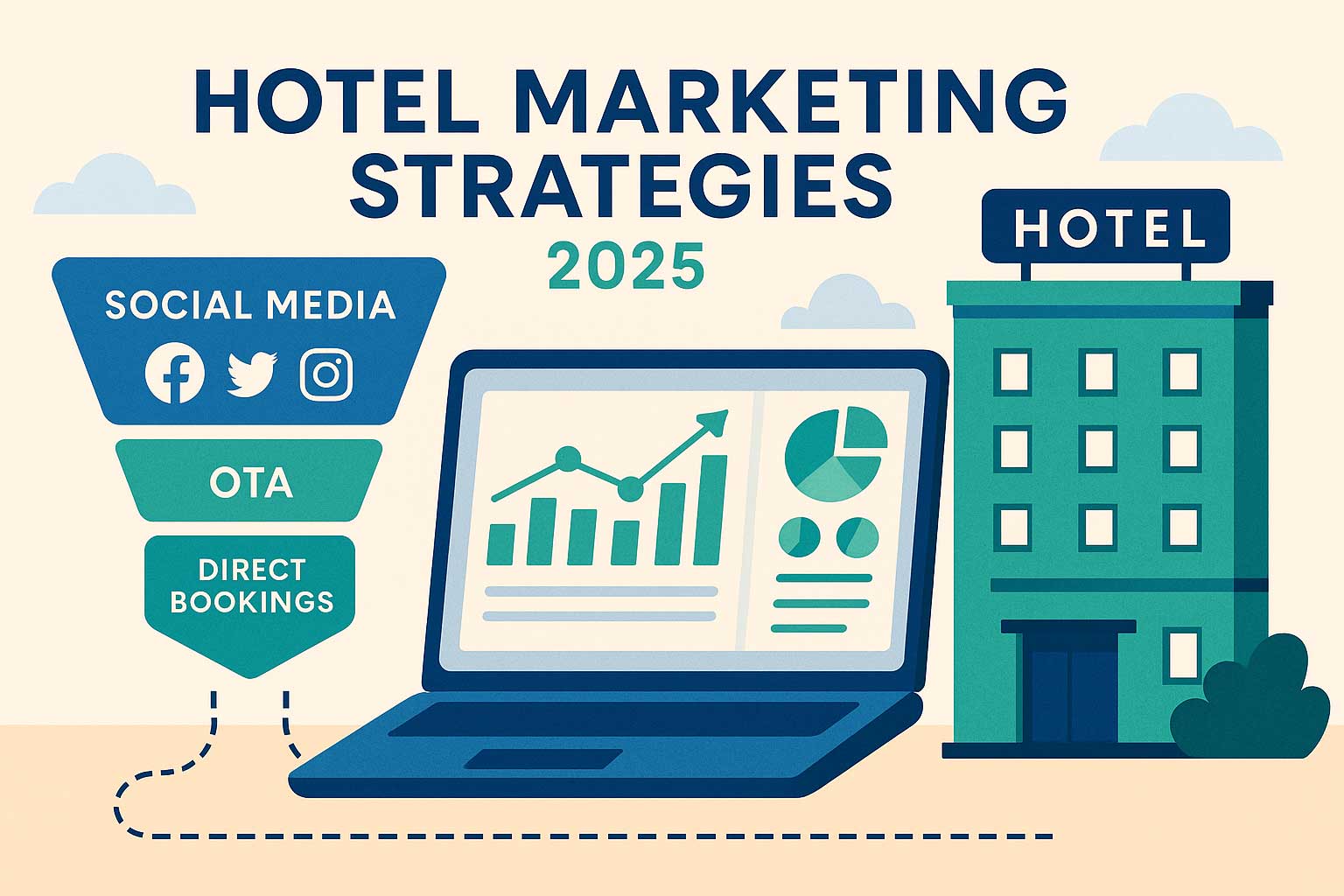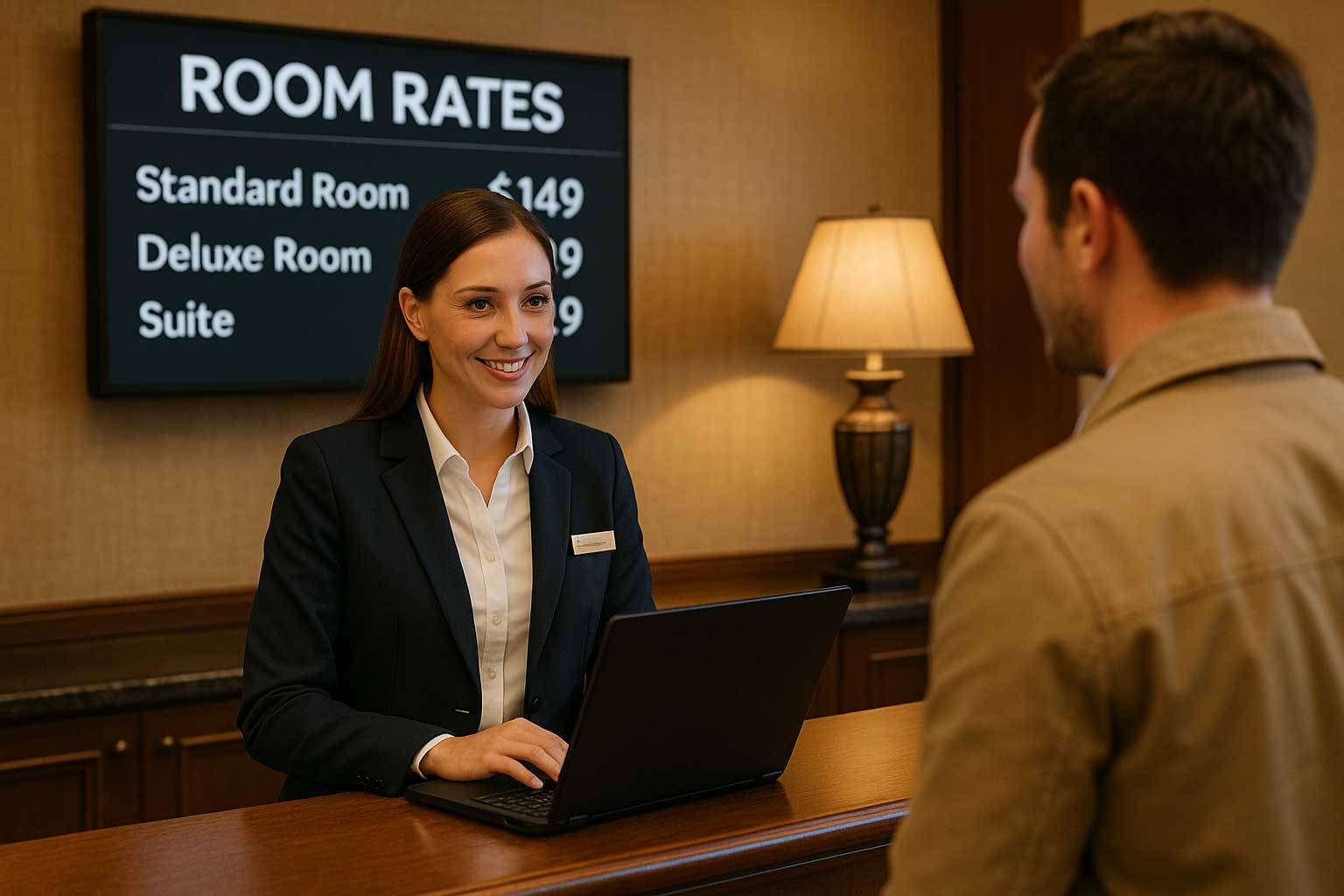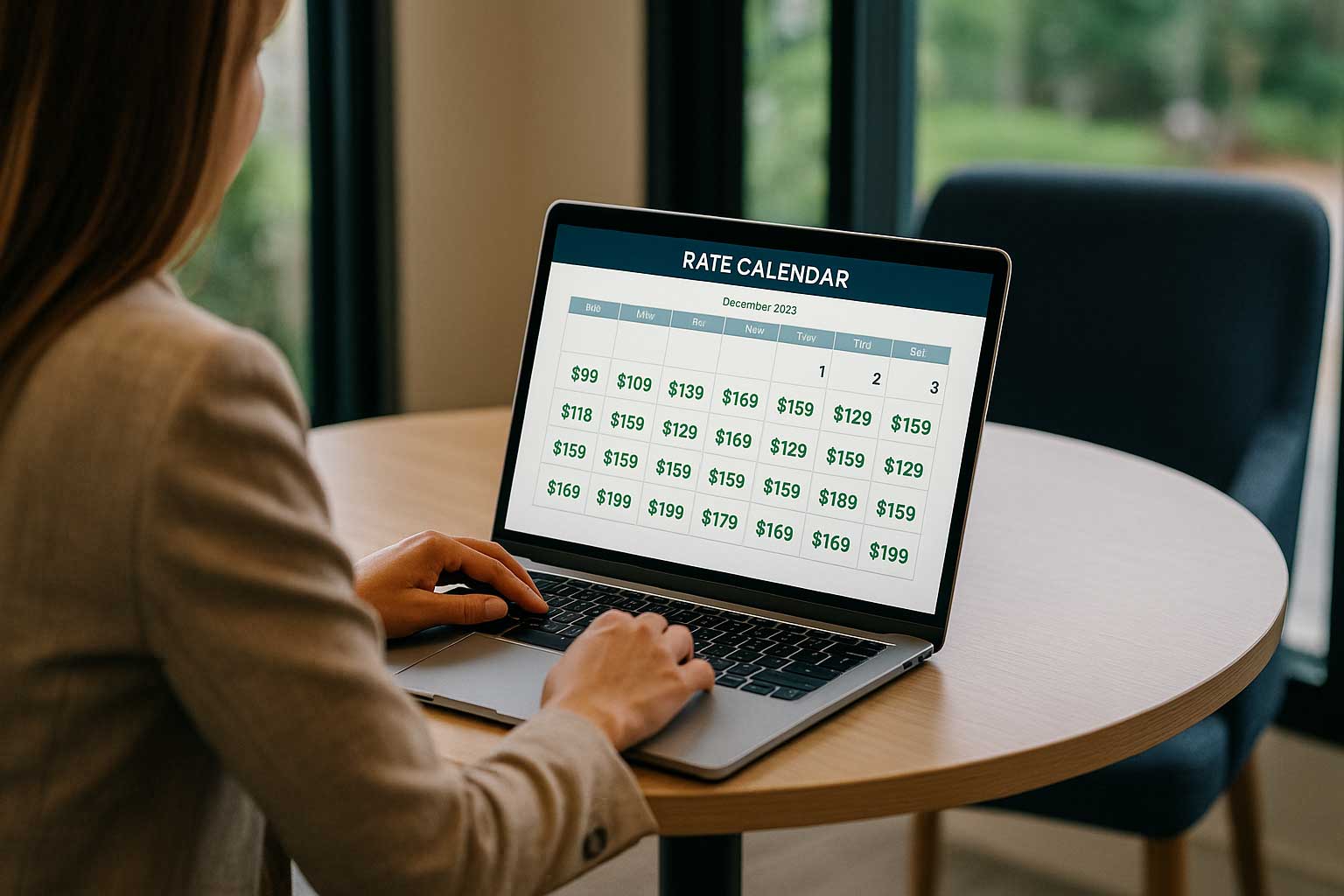Understanding Hotel Rates: A Complete Guide to Hotel Prices
Jul 27, 2025
 Mika Takahashi
Mika TakahashiPopular Categories
Hotel Technology & InnovationHotel Operations OptimizationDigital MarketingIndustry TrendsRevenue ManagementHospitality Industry
Popular Categories
Trending Post

Hotel Walk Letter Template: Professional Guest Communication

Online Travel Agents: What They Are and How They Work

Hotel Security Systems: Modern Protection Solutions

Hotel Advertising: Complete Guide to Boost Bookings and Revenue

25 Hotel Marketing Strategy Ideas for 2025: Complete Guide

AI Reservation Agent: Revolutionizing Hotel Booking and Guest Experience

PMS Communication: Streamlining Property Management Through Effective Guest Messaging
Table of contents
Hotel pricing has moved past the basic rates which used to be displayed at front desks. The hospitality industry operates through advanced pricing systems which create confusion for both new industry members and traveling customers. The multiple hotel rate systems require knowledge from anyone who wants to book hotels or work in the travel industry.
Hotel rates function as economic fundamentals for hospitality businesses because they generate revenue while serving as strategic tools to draw guests and optimize revenue potential. The hotel uses different rate types to achieve its pricing strategy goals which range from rack rates to wholesale prices.
The following guide provides complete information about all hotel rate types currently used in the industry together with their definitions and practical applications. The guide provides complete information about hotel rates to revenue managers who optimize pricing strategies and business travelers who need to understand their options and anyone interested in hotel pricing mechanics.
What Are Hotel Rates and Why They Matter
Hotels establish official room prices through Hotel rates which apply to specific time periods and represent nightly costs. The hotel sets each rate according to the expected payment range of specific guest segments who consider stay duration along with amenities and guest type and booking channels and time of booking. Hotel rates function as more than booking platform numbers because they demonstrate market positioning and customer segment capture strategies.
Hotel rates create effects that reach further than basic revenue creation. Hotel guests make their booking choices based on price comparisons between different hotels and booking platforms because they evaluate the value they receive from their selected rates. Business travelers choose rates with flexibility for changes but leisure travelers select the cheapest available option for their specific travel dates.
Hotels use their rates to generate revenue because they directly affect both occupancy levels and average daily rate (ADR) which combine to produce Revenue Per Available Room (RevPAR). Hotel managers face a dual challenge of maintaining competitive rates while maximizing revenue which makes rate setting an essential operational decision.
Evolution from Simple to Complex Pricing
Hotel pricing followed a simple approach during historical times. Hotels displayed their standard room rates through published rack rates which guests could find at the front desk or in marketing materials. The hotel industry transitioned to a competitive market environment which led to the development of multiple specialized rates and complex dynamic pricing systems.
Hotels implement advanced algorithms and revenue management systems which modify their prices several times daily through analysis of market conditions and competitor rates and guest demand patterns and segmentation data. Hotels now use this development to generate more revenue through customized options which meet individual guest requirements.
Key Stakeholders in Rate Setting
Several key players influence how hotel prices are set and managed:
Revenue managers oversee rate setting and adjust strategies to maximize profit and occupancy by using data-driven systems and historical data to make informed decisions. These professionals analyze everything from local events to weather patterns to optimize pricing.
Hotel owners and operators approve rate policies and balance immediate revenue needs with long-term asset value. Hotel owners and operators need to consider brand positioning and market reputation when setting rate parameters.
Brand standards determine rate naming conventions and eligible discounts and channel restrictions which maintain consistency across properties while enabling local market adaptation.

Primary Hotel Rate Types
Hotels organize their rates through a structured system which starts with the highest published rate followed by decreasing levels of discounts and specialized rates. Hotels use this pricing structure to understand their revenue management approach.
Rack Rates: The Foundation of Hotel Pricing
The highest publicly available room rate for each category represents the rack rate which applies to all guests without any promotional offers or membership benefits or package discounts. The official "sticker price" functions similarly to the Manufacturer’s Suggested Retail Price (MSRP) for consumer goods.
During the time when hotels displayed rate cards on racks behind front desks the term "rack rate" emerged. The practice maintained legal compliance and pricing transparency for regulatory bodies and guests by creating a standard reference point for all pricing.
Hotel operations today use rack rates as reference points but do not actually charge these rates to guests. All discounted rates—whether promotional, group, or contracted—are calculated as a percentage or fixed amount off the rack rate. The hotel's rate structure depends on revenue managers using rack rates as the foundation for all their pricing calculations.
The prices of hotel rooms at different market segments and star ratings fall into distinct ranges.
- Budget hotel rack rates: $80–$120 per night
- Midscale hotel rack rates: $120–$200 per night
- Luxury hotel rack rates: $300–$600+ per night
The published rack rates establish the maximum legal pricing limit in certain regulatory areas and function as the upper boundary for rate fences that determine discount eligibility.
Best Available Rate (BAR): Market-Responsive Pricing
The Best Available Rate (BAR) stands as the lowest unrestricted rate that hotels offer for specific room types during particular dates and guest capacities. The actual price that most guests pay when booking directly or through major Online Travel Agencies (OTAs) is represented by BAR rather than rack rates.
The main distinction between hotel BAR rates and rack rate stems from their usage and adaptability. The BAR rate changes daily and sometimes multiple times per day because it responds to real-time supply and demand factors. The best flexible rate adjusts its pricing based on market conditions and occupancy levels and competitor rates and local events.
Yield management operates through the central component known as Best Available Rate (BAR) which also functions as demand-based pricing. Revenue managers modify the BAR through assessments of several key elements including:
- Current and projected occupancy levels
- Competitor pricing in the local market
- Major events or conferences in the city
- Seasonal demand patterns
- Historical data from previous years
Hotels must maintain rate parity across their website and OTAs and Global Distribution Systems (GDS) because of the rules that govern these booking channels. The violation of rate parity standards leads to distribution penalties and potential termination of booking platform agreements.
Hotel brands provide Best Rate Guarantees (BRG) which guarantee their website rates match or exceed any visible BAR rates on the internet. Hotels provide refunds or price matches to guests who discover lower rates elsewhere which promotes direct bookings while protecting their rate structure.
Discounted Rate Categories
Hotels use multiple discount strategies based on the BAR or rack rate to draw various guest types while maximizing revenue through different market situations and guest booking patterns.
Package and Bundled Rates
Hotels use package rates to merge accommodation with extra services or amenities which creates perceived value and produces additional revenue streams for the hotel.
Bed & Breakfast Packages - Hotels usually price their Bed & Breakfast Packages at 15-25% higher than the standard room rate. Hotels use these packages to provide guests with convenience and value perception while generating additional food and beverage revenue.
All-Inclusive Rates - All-Inclusive Rates provide guests with a single payment that includes hotel stays together with dining expenses and drink options and access to resort facilities. Destination resorts commonly use these rates to help guests spend more money within the property while making their stay more convenient. The use of all-inclusive pricing by resorts enables better revenue forecasting and minimizes guest decision fatigue.
Specialized Experience Packages - Specialized Experience Packages unite hotel room prices with spa services and dining options and activity benefits and themed extras. The packages include spa packages and romance packages for anniversaries and honeymoons and adventure packages that provide equipment rental and guided tours.
Event Packages - Event Packages provide group bookings with sleeping room rates combined with event space and catering services and meeting amenities. The packages serve weddings and conferences and corporate retreats because they provide both accommodation and event service needs for their guests.
The main advantage of bundling is that it increases the average guest spend while providing clear value propositions that differentiate the hotel from other properties that only offer simple room rates.
Promotional and Time-Sensitive Rates
Hotels employ different promotional methods to attract bookings during specific times and to reach budget-conscious guests who will accept particular limitations.
Advance Purchase Rates - Hotels provide Advance Purchase Rates which give customers discounts between 10% and 30% when they book their stay before a specific time period before arrival while requiring non-refundable payments. Marriott offers a "Advance Purchase Rate" which gives customers 15-20% off their bookings when they reserve their stay at least 21 days ahead of time. Hotels use these rates to obtain advance bookings which enhances their ability to predict future occupancy levels.
Last-Minute Deals - The Last-Minute Deals program offers discounted rates to customers who book their stays between 24 to 72 hours before arrival for unsold rooms that would otherwise go unoccupied. Travelers who can adjust their plans may find substantial discounts through these last-minute rate promotions.
Flash Sales - Flash Sales operate as limited-time promotions which span from several hours to multiple days while offering customers discounts between 20-50% off. Major booking platforms use email campaigns and mobile app notifications to promote these deals which creates a sense of urgency that leads to quick bookings.
Seasonal Promotions - Hotels use Seasonal Promotions to offer special packages and reduced rates during particular travel times. Hotels offer “Summer Staycation” packages during peak times and “Winter Getaway” packages during off-peak times. Hotels use these promotions to keep their facilities occupied during their usual low-occupancy times.
Major hotel chains have successfully used promotional campaigns to increase off-peak occupancy. Hilton’s periodic “Flash Sale” campaigns consistently boost occupancy by double digits during low-demand periods, demonstrating the effectiveness of strategic promotional pricing.
Qualified Member Rates
Hotels provide special membership rates to particular organizations and loyalty programs which drive guests to book directly and show appreciation for their loyalty.
Loyalty Member Rates - Hotels reserve Loyalty Member Rates for their enrolled members who participate in programs such as Marriott Bonvoy and Hilton Honors. The hotel provides these rates through direct booking channels to its members who receive discounts ranging from 5% to 15% below the Best Available Rate (BAR). The hotel uses this approach to drive direct bookings while developing enduring customer connections.
Membership Organization Discounts include several standardized offerings:
AAA/CAA Rates provide members of North American automobile associations with a standard discount of 10% off their membership.
AARP/Senior Discounts provide discounts ranging from 5% to 15% for guests aged 50 and above who present proof of eligibility.
Military/Government Rates offer special pricing that requires valid identification but may be subject to government per diem limits.
Corporate Employee Rates - Hotels establish Corporate Employee Rates through agreements with major employers to provide reduced rates for business and leisure travel by employees of these companies. The rates extend to family members and often come with extra perks including extended check-out times and free breakfast.
Business-to-Business Contract Rates
Business-to-business rates differ from retail rates because they exist within private contractual agreements which serve intermediaries and large-volume buyers who need specialized pricing structures.
Net Rates and Agency Commissions
The wholesale prices that exclude standard retail price increases are known as net rates. The rooms purchased by travel agents and OTAs and brokers at net rates become the basis for their own pricing structure which includes service fees and markup.
Traditional travel agents and corporate travel management companies receive 10-15% commission from the published rates. The digital marketplace has transformed the commission structure into two main online distribution models:
Merchant Model: The Merchant Model allows OTAs to buy hotel rooms at discounted net rates which they then sell to customers at higher prices to generate profit from the price difference. The OTAs gain pricing control through this model but they must bear the responsibility of inventory management.
Commission Model: The Commission Model operates through Booking.com by displaying hotel set retail rates to customers while the platform earns its commission from the hotel after guests make direct payments to the hotel. The model protects hotels from OTA risks while allowing them to maintain pricing control.
High-volume partners can negotiate increasingly favorable net rates or tiered discounts in exchange for committed room blocks or prominent placement in search results. These negotiations often involve complex agreements covering everything from marketing support to exclusive rate access.
Corporate and Group Rates
The negotiation process with businesses leads to the development of corporate contract rates because they need predictable booking volumes. The agreements offer businesses 15-30% rate reductions in exchange for annual room night guarantees or minimum spending requirements.
Corporate contracts often specify important terms like:
- Blackout dates when discounted rates aren’t available
- Last-room availability guarantees ensuring corporate rates remain accessible unless the hotel is completely sold out
- Specific booking and billing procedures
- Extended payment terms for large accounts
Group booking rates - apply to blocks of typically 10 rooms or more, offering special pricing for conferences, weddings, conventions, or tour groups. These rates often include additional amenities like welcome receptions, complimentary meeting space, or group dining packages.
Meeting and event packages - The packages for meetings and events include sleeping room rates together with conference facilities and catering services and audiovisual equipment. The revenue structure depends on whether clients want bundled packages or separate itemization according to their preferences and accounting needs.
Long-term stay rates - Hotels offer substantial discounts through long-term stay rates when guests book accommodations for seven nights or longer. Hotels offer these rates which reduce standard nightly prices by 15-40% to attract relocating executives and project teams and extended leisure travelers while maintaining hotel occupancy levels.
Wholesaler and Distribution Rates
Hotels use different intermediaries to connect with various market segments and geographic regions through specific distribution channels.
Bed Banks and Tour Operators - Tour Operators together with Bed Banks acquire hotel inventory at reduced wholesale prices to combine with flights and other travel services. Hotelbeds functions as an intermediary to take inventory risk in exchange for volume commitments and preferred pricing.
OTA Merchant Rates - Through OTA Merchant Rates online travel agencies operating as merchants acquire room blocks at discounted prices to sell to worldwide consumers while taking responsibility for pricing and unsold inventory. Hotels gain access to international markets through this model which they would normally be unable to reach directly.
Global Distribution System (GDS) Rates - enable travel agents to access special rates through professional reservation systems using specific codes. The rates match corporate and government standards while providing automatic eligibility checks and standardized booking protocols.
Dynamic vs. Static Pricing Strategies
The hotel industry has experienced a complete change in its rate-setting and management practices by moving from basic and stable pricing systems to advanced real-time rate optimization systems.
Static Rate Management
Hotels used to manage their rates through traditional static methods which depended on seasonal or annual rate cards that appeared in brochures and displayed at front desks. Hotels set fixed rates for their high season and shoulder season and off season periods while offering pre-set discounts to senior citizens and AAA members and advance bookers.
The main benefit of static pricing included both predictable and transparent pricing methods. Hotel guests could make travel plans based on established rates which staff members could provide directly without needing system assistance. The method continues to be widely used in areas with basic technology infrastructure and strict rules about rate disclosure.
The fixed pricing system prevented hotels from capturing additional revenue during unexpected high demand periods and it also prevented them from attracting more guests during slow periods by lowering rates.
Dynamic Pricing Implementation
Hotels in the modern era rely on advanced revenue management technology to operate dynamic pricing systems which analyze multiple data points for real-time rate adjustments. These systems consider factors including:
- Current and projected occupancy levels
- Competitor pricing across the local market
- Historical booking pace and patterns
- Local events, conferences, and seasonal factors
- Weather forecasts and their impact on demand
- Economic indicators and travel trends
Hotels adjust their rates multiple times daily through dynamic pricing systems which some properties update hourly when demand is high. Hotel rates increase substantially during Super Bowl events and large conventions because demand rises rapidly while supply runs out.
The implementation of dynamic pricing systems enables hotels to achieve maximum revenue while optimizing occupancy and immediate market response capabilities. Hotels implementing advanced revenue management systems achieve RevPAR improvements between 2-7% through their use of sophisticated pricing methods instead of traditional static pricing.
The implementation of dynamic pricing systems creates various operational difficulties. Hotel customers become dissatisfied when they notice rate fluctuations during their search process while hotels face potential price competition from rival properties that operate automated systems. The technical complexity demands continuous investments for technology development and staff training programs.

Rate Determination Factors and Best Practices
Hotel rate management success depends on multiple elements which need to be handled through established industry methods that optimize revenue while maintaining guest satisfaction and market position.
Market Analysis and Competitive Positioning
The foundation of effective rate setting requires complete market analysis. Hotels perform automated competitor rate shopping to check rival properties multiple times daily for competitive positioning purposes. Revenue managers review competitor pricing at present while also studying their booking speed and availability together with promotional strategies.
Hotels use market demand analysis to combine local events with seasonal patterns and historical booking data and broader economic factors. Hotels monitor convention calendars and concert schedules to make proactive rate adjustments for upcoming high-demand periods.
Hotels make strategic positioning choices to decide between premium pricing and value positioning and competitive parity approaches. Luxury hotels keep their rates high during peak times yet budget hotels use aggressive pricing to reach maximum occupancy levels.
Hotels aim to optimize RevPAR by discovering the perfect combination of average daily rate and occupancy levels which produces the highest total revenue per available room. Hotels choose to accept reduced occupancy during peak times to earn higher rates while targeting more bookings during slow periods at lower profit margins.
Cost-Based Rate Calculations
Hotels need to understand their cost structure because market factors drive rate setting but hotels must ensure profitability across different rate categories. Operating costs consist of housekeeping expenses together with utilities and maintenance costs and labor expenses and variable expenses which adjust based on occupancy levels.
Hotels must pay fixed costs which include mortgage payments together with property taxes and insurance and franchise fees and other expenses that stay unchanged regardless of occupancy levels. Revenue managers need to guarantee that variable costs get covered by discounted rates which also help pay fixed costs.
Hotels aim to achieve profit margins ranging from 15% to 25% above their total costs but actual margins differ substantially because of competitive market forces and market conditions and strategic goals. The break-even analysis helps hotels calculate the minimum occupancy needs at different rate points which guides their decisions about group bookings and promotional rates.
Revenue Management Best Practices
The implementation of systematic approaches to rate optimization and performance monitoring stands as a necessity for successful revenue management. Hotels perform regular rate audits to maintain booking channel consistency while ensuring proper discount application and rate parity compliance.
The combination of historical data with current booking pace and market intelligence and external factors enables demand forecasting to predict future demand patterns. Hotels that operate at a sophisticated level employ machine learning algorithms to detect hidden patterns in guest conduct and market trends.
Hotels use inventory management to control room availability through rate categories by shutting down lower-yield rates when demand is high to protect their average daily rate. Hotels use rate fencing as a practice to maximize revenue during peak times.
The performance monitoring system tracks ADR alongside occupancy and RevPAR and booking pace metrics which are compared to historical data and budget targets. Revenue managers check these metrics every day to modify their strategies according to performance patterns and market feedback.
The training of staff includes teaching front desk personnel about rate policies and discount authorization levels as well as correct procedures for handling rate-related guest inquiries. Staff members who receive proper training can stop revenue loss while building excellent guest connections when explaining rate limitations or modifications.
Conclusion
Hotels implement advanced pricing strategies to optimize revenue while maintaining guest satisfaction through their complex rate management systems. The hotel revenue strategy depends on rack rates as its base pricing structure while dynamic pricing systems adjust rates multiple times daily to achieve specific revenue goals.
The hotel industry transitioned from basic rack rate pricing to advanced systems which include discounted rates and promotional offers and dynamic pricing because of market changes and guest expectations. The ability to understand different rate categories helps both business travelers and leisure visitors and hospitality workers make better choices.
Hotel rates will advance in complexity because of technological progress and shifting consumer behavior patterns in the travel industry. The core principles of delivering value to guests and maximizing hotel revenue will stay unchanged. The knowledge of rate structures provides both travelers and industry professionals with better tools to handle hotel pricing complexities effectively.
Travelers who understand rate structures can make better booking choices and find optimal value for their requirements. Hospitality professionals need to understand these concepts because they form the basis for successful revenue management and competitive market positioning in today's complex hospitality industry.
